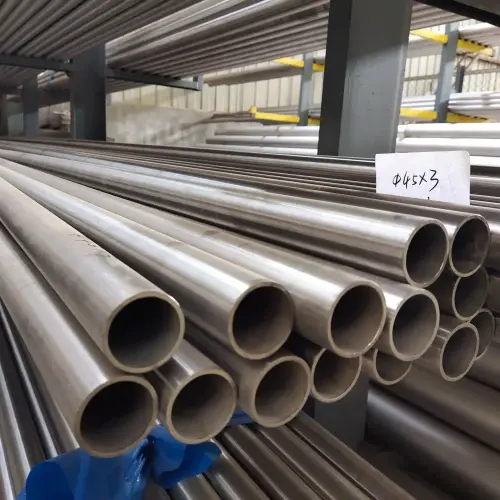Why Understanding Titanium Tube Grades Matters
Titanium tubes are highly valued in industrial applications due to their exceptional properties; however, significant differences exist between grades in terms of performance, cost, and applications. As a procurement decision-maker or engineer, understanding the core differences between GR2 titanium tubes and GR5 titanium tubes will help you make informed material selections, avoiding unnecessary costs or performance shortcomings. This in-depth guide examines the key distinctions between these two widely used titanium tubes to help you identify the optimal solution for your project needs.

Chemical Composition: Fundamental Differences
Grade 2 Titanium Tubes (GR2) belong to the commercially pure titanium series, containing over 99% titanium with only trace amounts of other elements like iron and oxygen. This high purity provides excellent corrosion resistance but limits its strength potential.
In contrast, Gr5 Titanium Tubes are titanium alloys containing 6% aluminum and 4% vanadium (commonly called Ti-6Al-4V). This alloy formulation significantly enhances mechanical properties:
Aluminum: Increases strength and heat resistance
Vanadium: Improves toughness and stabilizes microstructure
Combined effect: Creates an optimal balance of strength and durability
These fundamental chemical differences directly impact their mechanical properties, corrosion resistance, and workability, consequently influencing their appropriate applications.
Mechanical Properties: Strength vs. Ductility
Tensile Strength comparison:
Grade 2: ~345 MPa
Grade 5: ~895 MPa (2.6× stronger)
Yield Strength difference:
Grade 2: ~275 MPa
Grade 5: ~828 MPa (3× higher)
Elongation shows the opposite trend:
Grade 2: ~20%
Grade 5: ~10%
Hardness variation:
Grade 2: ~120 HB
Grade 5: ~334 HB
These comparisons demonstrate Grade 5's clear advantage in high-strength applications, while Grade 2 is better suited for applications requiring good formability. Notably, despite its higher strength, Grade 5 maintains excellent fracture toughness, making it ideal for critical applications like aerospace.
Corrosion Resistance: Environmental Compatibility
While Grade 5 outperforms in strength, Grade 2's pure composition offers advantages in certain corrosive environments:
General corrosion: Comparable performance in most environments (seawater, chloride solutions, etc.)
Stress corrosion cracking (SCC): Grade 2 shows better resistance, especially in hot chloride environments
Crevice corrosion: Grade 2 performs better in aggressive environments (hot concentrated chloride solutions)
Biocompatibility: Grade 2 is preferable for long-term medical implants
Although Grade 5 maintains good overall corrosion resistance, its alloying elements may create micro-galvanic cells in extreme conditions, slightly increasing localized corrosion risks. For most industrial applications, their corrosion resistance is similar, but in specific harsh environments, this difference may become a critical selection factor.
Workability and Welding Characteristics
Grade 2 Titanium Tubes machining features:
Easier cold forming (bending, expanding, etc.)
Excellent weldability with weld zone properties similar to base metal
Reduced tool wear during machining
Better suited for complex-shaped components
Grade 5 Titanium Tubes machining challenges:
Higher strength requires greater machining forces
Poor thermal conductivity leads to tool overheating
Requires specialized tools and coolants
Welding needs strict parameter control, often requiring post-weld heat treatment
In production, machining Grade 2 typically costs 15-30% less than Grade 5, with this difference becoming more significant in high-volume production. For components requiring complex machining or welding, Grade 2 often proves more economical.
Temperature Performance: High and Low-Temperature Behavior
Temperature resistance is critical for many industrial applications:
Cryogenic performance:
Grade 2: Maintains good toughness at extremely low temperatures, suitable for LNG equipment
Grade 5: Higher strength at low temperatures but slightly reduced toughness
High-temperature performance:
Grade 2: Recommended for continuous service below 300°C
Grade 5: Suitable for long-term use at 400°C, short-term exposure up to 600°C
Grade 5 demonstrates more advantages in thermal cycling or fatigue conditions. Its superior creep resistance and oxidation stability make it ideal for high-temperature applications like aircraft engines.
Cost Analysis: Initial Investment vs. Lifecycle Cost
Price comparison:
Grade 5 typically costs 1.5-2.5× more than Grade 2
The Price difference comes from alloying elements and processing difficulty
Cost-effectiveness considerations:
Initial cost: Grade 2 is more economical
Weight savings: Grade 5's strength allows thinner designs, potentially reducing total system cost
Service life: Proper material selection can significantly extend maintenance intervals in harsh environments
Failure consequences: Wrong selection in critical applications may lead to costly downtime
Smart procurement decisions should be based on Total Cost of Ownership (TCO) rather than just initial material cost. For non-critical applications, Grade 2 often offers better economics, while for high-performance or long-life designs, Grade 5 may provide better return on investment.
Typical Applications Comparison
Grade 2 (GR2) common applications:
Chemical processing equipment: heat exchangers, reactors, piping systems
Desalination plants: evaporators, condensers
Medical implants: non-load-bearing bone screws, surgical instruments
Architectural elements: curtain walls, roofing materials
Grade 5 (GR5) preferred applications:
Aerospace: engine components, hydraulic systems, airframe structures
High-performance automotive: racing drive shafts, suspension components
Marine engineering: deep-sea submersible pressure hulls
Orthopedic implants: load-bearing devices (joint replacements, bone plates)
Selection warning: Avoid choosing Grade 5 based solely on "higher grade means better" thinking. In many corrosion-dominated applications, Grade 2 not only costs less but may perform better. The key is identifying primary versus secondary application requirements.
Selection Guide: Decision Flowchart and Practical Advice
Material selection process:
Identify primary performance requirements (strength/corrosion resistance/temperature, etc.)
Evaluate secondary needs (weldability/weight/cost, etc.)
Consider manufacturing methods and complexity
Calculate total lifecycle cost
Conduct real-environment testing when necessary
Practical selection tips:
Prefer Grade 2 when corrosion resistance is primary, complex forming is required, the budget is limited, and non-load-bearing medical use
Prefer Grade 5 when: high strength needed, high-temperature environment, weight reduction critical, load-bearing medical implants
Intermediate option: Consider whether a thicker Grade 2 design could meet strength requirements
Professional consultation: For borderline cases, consult materials engineers or supplier technical departments
Frequently Asked Questions
Q: Can Grade 5 completely replace Grade 2 titanium tubes?
A: Not simply. While Grade 5 offers higher strength, Grade 2 may be more suitable for certain corrosive environments and forming requirements. Replacement requires a comprehensive evaluation of all performance needs.
Q: Can these two grades be welded together?
A: Technically possible, but requires special procedures. Generally not recommended due to potential brittle phase formation at the joint. If necessary, use pure titanium filler metal with strict parameter control.
Q: How to visually distinguish Grade 2 from Grade 5 tubes?
A: Nearly impossible by appearance alone. Reliable methods include: material certification check, chemical analysis, or hardness testing. Reputable suppliers mark the grade on tubes.
Q: Which grade is better for food industry applications?
A: Both meet food-grade requirements, but Grade 2 is more commonly used due to its superior corrosion resistance, lower cost, and higher purity for direct food contact.
Q: Is Grade 5's higher cost always justified by its performance advantages?
A: Not always. The premium cost only makes sense when its high strength and temperature resistance are genuinely needed. In many applications, Grade 2 offers the best value.
Conclusion: Smart Selection Creates Maximum Value
Grade 2 and Grade 5 titanium tubes each have irreplaceable advantages in their respective fields—there's no absolute "better," only "more suitable." After understanding the key differences outlined here, you'll be able to:
Avoid paying premiums for unnecessary performance
Identify applications that truly require high-grade materials
Communicate more professionally with suppliers
Optimize designs for the best cost-performance balance
We recommend bookmarking this guide for future reference in material selection. For project-specific advice, please contact our materials expert team for professional consultation. Email: linhui@lhtitanium.com











